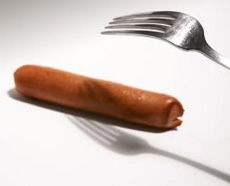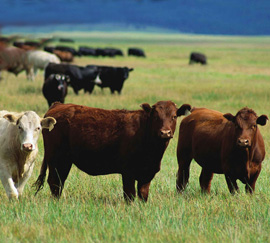
 Organic or regular: big difference! Photo by Sarah Lewis | SXC.
|
STEPHANIE ZONIS focuses on good foods and the people who produce them.
|
|
September 2006
Updated June 2009
|
 |

Organic Hot Dogs Vs. Conventional Hot Dogs
Page 5: Grass-Fed Beef
Click here to read other Organic Matter columns
This is Page 5 of a six-page article. Click on the black links below to read the other sections.
There’s also the grass-fed versus conventionally-fed issue. Once upon a time in the U.S., all beef was produced from animals that grazed at will on pasture, because that’s what was available. Gradually, however, land in the U.S. became increasingly expensive, land was over-grazed and poorly managed and smaller-scale ranches and farms began to give way to agribusiness. Nowadays, conventionally-raised beef and pork (as well as other animals raised for food) are confined to feedlots. Thanks in part to cheap, heavily-subsidized corn, their diets consist mostly of grain and soy, often genetically modified, as well as “byproducts” (don’t ask!). They’re given growth hormones and antibiotics. All of these measures keep producers’ costs down and get the animals ready for market far more quickly than in the old “pasture” days.
But a growing number of individuals and organizations have problems with this conventional system. Some of the problems stem from the issue of food safety, some are about humane treatment for animals.
There is a minority movement afoot, one that I believe will continue to grow, involving grass-fed beef. Grass-fed proponents argue that their beef is safer than conventionally-raised beef. They claim it’s more nutritious (especially in omega fatty acids), better for the environment, more humane for the cattle, and good for the small, independent farmers who raise their cattle this way. The phrase “grass-fed beef” conjures up an idyllic mental image of cattle grazing freely and contentedly on a large, grassy prairie…but wait! |
 Truly grass fed beef. Photo courtesy of USDA. Truly grass fed beef. Photo courtesy of USDA. |
There are, as of this writing, no USDA standards for grass-fed beef. The USDA is in the process of drawing up standards, and recently asked for public comment on their proposed rules. As is too often the case with the USDA, their proposed rules include a loophole through which one could drive an 18-wheeler. True, standards put forward by the USDA would require that 99% of a grass-fed animal’s diet over its lifetime would have to come from grass and/or forage, but as currently written, they do not require that the animal be allowed to graze. Producers could still confine cattle in feedlots, feed them a 99% grass-forage diet, and label their meat as “grass-fed.” That doesn’t sound humane to me, and it wouldn’t be beneficial to the environment or independent farmers. But a final decision has yet to be made. Currently, almost all grass-fed cattle are “finished” on a grain diet before slaughter, though some grass-fed animals are allowed to graze on pasture for far longer than their conventionally-fed cousins. You can find hot dogs made in the U.S. only from grass-fed beef, though not all are organic.
Hot dogs shouldn’t be so complicated, you say? Like anything else, scratch the surface and you’ve discovered a whole little world unto itself. This column is by no means a comprehensive look into the world of wieners. Although grass-fed proponents make some good arguments for their system of livestock management, there are issues other than just the proposed USDA standards. Over time, Americans have grown used to the taste of grain-fed beef. Grass-fed beef tends to be leaner, and it doesn’t have the same flavor; even the type of fat within the beef is different. Because of this, hot dog manufacturers using grass-fed meat have had to carefully manipulate formulations and processes to obtain a product that resembles the conventional frankfurter, even when the animals are finished on a grain diet. In one or two cases, the manufacturers haven’t bothered to do this, instead, leaving their product with a browner color and different texture and flavor. If and when grass-fed beef becomes more popular here, these variations could turn out to be important points of differentiation, ways to distinguish their products from hot dogs made with conventionally-produced beef.
Continue To Page 6: Hot Dog Taste Test
Go To Article Index Above

|




 Organic or regular: big difference! Photo by Sarah Lewis | SXC.
Organic or regular: big difference! Photo by Sarah Lewis | SXC. 